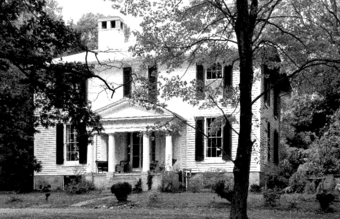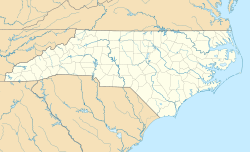Glenwood (Enon, North Carolina) facts for kids
Quick facts for kids |
|
|
Glenwood
|
|
 |
|
| Location | E of Enon on SR 1549, near Enon, North Carolina |
|---|---|
| Area | 39.9 acres (16.1 ha) |
| Built | 1837 |
| Architect | Tyre Glen, Martha Bynum Glen |
| Architectural style | Greek Revival |
| NRHP reference No. | 79001766 |
| Added to NRHP | August 13, 1979 |
Glenwood is a historic plantation with a beautiful Greek Revival style house. It also has several smaller buildings around it. You can find Glenwood near Enon in Yadkin County, North Carolina.
Contents
About Glenwood Plantation
Glenwood was once one of the biggest plantations in western North Carolina. It was built by Tyre Glen (1800–1875).
The Glenwood Estate
Tyre Glen completed the main house at Glenwood in 1837. This large house has 15 rooms and features Doric columns, which are a classic style of architecture. The foundation of the house was made from soapstone, a type of rock, that came from Glen's own quarry.
At its largest, the Glenwood estate was huge, covering about 6,000 acres (24 km2). Many enslaved people lived and worked on the property, around 360 of them at one time. Besides the main house, Glen's original property included a dam, a gristmill (for grinding grain), and a ferry crossing on the Yadkin River.
Today, the Glenwood house has been carefully restored and is a private home.
Important Visitors at Glenwood
Glenwood was a significant place for culture in the area. Many important people visited, including:
- North Carolina Governor Zebulon Vance
- North Carolina Chief Justice Richard M. Pearson
Tyre Glen was married to Margaret Ann Bynum. Her father was Hampton Bynum.
Glenwood During the Civil War
The American Civil War (1861-1865) brought many challenges to Glenwood.
Confederate Troops Visit
In 1863, about 50 Confederate soldiers from the 8th Battalion Georgia Infantry came to Glenwood without being invited. Tyre Glen was not happy about the idea of states leaving the United States (called Secession). His strong opinions angered the officers. They planned to trick him into leaving Glenwood and then hang him. Luckily for Glen, heavy rains washed away a bridge, and he was able to return home safely.
A Tragic Event at the Ferry
In July 1864, a sad event happened at Glen's Ferry. William Alexander Conrad, a local church member and part of the Home Guard (a local defense group), was shot. He thought he was trying to catch three army deserters crossing the river in a small boat. Conrad died several months later from his injuries. Years after the war, it was discovered that the men were actually Union soldiers who had escaped from prison and were trying to get back to Ohio.
The End of the War
Glenwood was raided several times as the Civil War continued. By the last raid in April 1865, most of the enslaved people had left the plantation. There were also no horses or cattle left. As the Confederate army broke apart, soldiers marched along the ferry road that went through the estate. For weeks, long tables were set up outside the house. Tyre Glen's family and the few remaining freed people gave food to all the soldiers who stopped by.
The Jarratt Family Connection
Isaac Jarratt (1812–1875) was a partner of Tyre Glen. He also settled in the Enon area. Jarratt had served as a drummer boy during the War of 1812. In 1835, he bought a plantation called the Davis Durrett plantation.
During the Civil War, Isaac Jarratt was the captain of the Yadkin County Home Guard. The Jarratt family also had connections to other important families in the area, like those of Thomas Lanier Clingman and Richard Clauselle Puryear from nearby Huntsville, North Carolina. The old Durrett-Jarratt House is also listed on the National Register of Historic Places.



